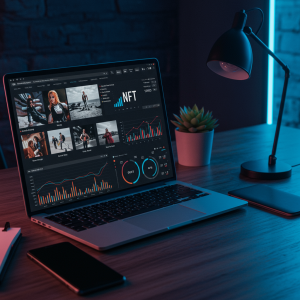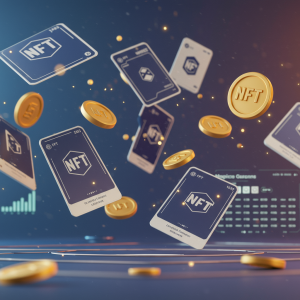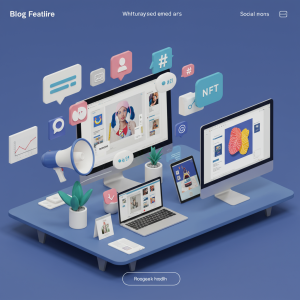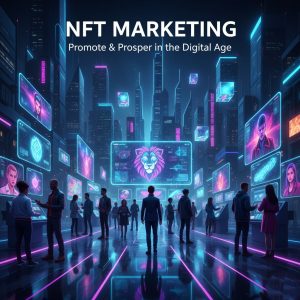SEO for NFTs: Optimizing Your Digital Assets for Maximum Discoverability

In a crowded NFT marketplace, visibility is everything. Even the most innovative digital collectible can languish unnoticed without the right search optimization strategy. By applying proven SEO techniques to your NFTs—just like you would for a website or blog—you can boost organic traffic, attract the right collectors, and ultimately increase sales.
Understanding SEO for NFTs

Search Engine Optimization (SEO) is the practice of improving a page’s visibility in search engine results by optimizing content, metadata, and technical factors. While traditional SEO focuses on websites and blogs, the same principles apply to NFT marketplaces and project landing pages. By treating your NFT collection as a piece of content to be discovered, you can leverage keyword research, on-page optimization, and link building to drive organic traffic to your digital assets.
Why SEO Matters for NFTs
- Higher Visibility: Optimize your listings to appear at the top of search results on Google and NFT marketplaces.
- Targeted Traffic: Attract collectors who are actively searching for the themes, styles, or utilities your NFTs offer.
- Long-Term Growth: Organic rankings compound over time, reducing reliance on paid ads and community outreach.
Keyword Research for Your NFT Collection
Effective SEO starts with identifying the right keywords—terms and phrases your target audience uses when looking for NFTs like yours. Follow these steps to conduct thorough keyword research:
Brainstorm Core Themes
List the main concepts, artistic styles, or utilities that define your collection. Are your NFTs pixel art, 3D animations, generative art, or utility-based tokens? Each theme becomes a seed keyword.
Use Keyword Tools
Leverage tools such as Google Keyword Planner, Ahrefs, SEMrush, or Ubersuggest. Enter your seed keywords and analyze:
- Search Volume: Monthly searches on Google for the term.
- Keyword Difficulty: How hard it is to rank for that term.
- Related Terms: Long-tail variations, questions, and synonyms.
Prioritize Long-Tail Keywords
Long-tail keywords (e.g., “pixel art fantasy NFT collection”) have lower competition and often higher conversion rates. Target a mix of broad terms (“NFT art”) and niche phrases to cover different stages of the buyer’s journey.
On-Page Optimization for NFT Listings
Once you’ve selected your focus keywords, integrate them strategically into your NFT listings and project pages. Key on-page elements include:
Title Tag and Listing Name
Include your primary keyword in the NFT title. For example: “Pixel Art Fantasy NFT Collection – 1,000 Unique Generative Avatars”. Keep it under 60 characters so it displays cleanly in search results.
Meta Description
Write a compelling summary (120–160 characters) that incorporates the keyword and encourages clicks. E.g.: “Discover our Pixel Art Fantasy NFT Collection: 1,000 unique avatars with rare traits. Mint now on Ethereum!”
tags to break content into scannable sections. Search engines value clear hierarchies.
Description and Storytelling
Craft a narrative around your NFTs: inspiration, artistic process, utilities, and roadmap. Naturally weave in target keywords while keeping the tone engaging and authentic.
Image Alt Text
Assign descriptive alt text to your NFT images, like “Pixel art dragon avatar with fiery wings – NFT”. This helps both accessibility and image search rankings.
Technical SEO Considerations
Technical factors influence how easily search engines crawl and index your NFT pages. Address these elements to maximize visibility:
URL Structure
Use clean, keyword-friendly URLs: “example.io/collections/pixel-art-fantasy” rather than “example.io/collection123?ref=abc”.
Mobile Optimization
Ensure your project website and marketplace listings are mobile-responsive. Google’s mobile-first indexing prioritizes mobile-friendly pages.
Page Speed
Optimize image file sizes (without sacrificing quality) and leverage lazy loading. A fast-loading page improves user experience and SEO rankings.
Schema Markup
Implement JSON-LD structured data tailored for creative works, collections, and offers. This helps search engines understand your NFTs’ properties and can enable rich snippets in results.
XML Sitemap
If you host your own project website, submit an XML sitemap listing your collection and individual NFT pages to Google Search Console.
Content Marketing & Blogging
Beyond marketplace listings, create a content hub—blog posts, tutorials, and behind-the-scenes articles—to attract organic traffic and demonstrate authority in your niche.
Thematic Blog Posts
Publish articles such as “The Making of Pixel Art Fantasy: Tools & Techniques” or “How to Choose the Perfect NFT Avatar”. Target long-tail keywords and link back to your collection pages for internal SEO benefits.
Guest Posting
Contribute to high-domain-authority crypto and digital art blogs. Include a contextual link to your project site or marketplace listing to build referral traffic and improve SEO juice.
Community Guides
Create how-to guides for platforms like OpenSea, Rarible, or Foundation, showcasing your expertise. Embed examples from your collection and optimize the guide for relevant keywords.
Off-Page SEO & Link Building
Building a network of quality backlinks is crucial for signaling trust and authority to search engines. Strategies include:
Influencer Collaborations
Partner with crypto influencers or NFT collectors who can feature your collection on their blogs or social channels, generating natural backlinks.
Press Releases
Distribute newsworthy announcements—drops, partnerships, or charity auctions—through reputable crypto and art news outlets. Include links to your project page.
Social Signals
While social shares aren’t a direct ranking factor, high engagement on Twitter, Discord, and specialized NFT forums can lead to organic backlinks and increased referral traffic.
Measuring & Refining Your SEO Efforts

Consistent monitoring ensures you stay ahead of trends and maintain top rankings. Key metrics to track:
- Organic Traffic: Visits from search engines to your project site or listing pages.
- Keyword Rankings: Position changes for your target keywords.
- Backlink Profile: Quantity and quality of sites linking to your pages.
- Conversion Rate: Percentage of visitors who mint or purchase an NFT.
Use tools like Google Analytics, Google Search Console, and Ahrefs to gather data. Regularly audit your on-page content and technical setup, and iterate based on insights.
Conclusion
Applying SEO principles to your NFT projects is a long-term strategy that compounds as you produce more content and earn authoritative backlinks. By mastering keyword research, on-page optimization, technical SEO, content marketing, and link building, you’ll unlock sustainable organic growth—ensuring your digital collectibles reach the right audience and achieve the recognition they deserve.
Ready to level up your NFT discoverability? Start by auditing your current listings against these SEO best practices, then watch as your organic traffic and sales climb.





